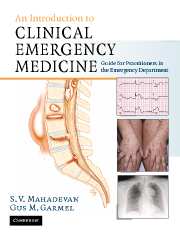Book contents
- Frontmatter
- Contents
- List of contributors
- Foreword
- Acknowledgments
- Dedication
- Section 1 Principles of Emergency Medicine
- Section 2 Primary Complaints
- 9 Abdominal pain
- 10 Abnormal behavior
- 11 Allergic reactions and anaphylactic syndromes
- 12 Altered mental status
- 13 Chest pain
- 14 Constipation
- 15 Crying and irritability
- 16 Diabetes-related emergencies
- 17 Diarrhea
- 18 Dizziness and vertigo
- 19 Ear pain, nosebleed and throat pain (ENT)
- 20 Extremity trauma
- 21 Eye pain, redness and visual loss
- 22 Fever in adults
- 23 Fever in children
- 24 Gastrointestinal bleeding
- 25 Headache
- 26 Hypertensive urgencies and emergencies
- 27 Joint pain
- 28 Low back pain
- 29 Pelvic pain
- 30 Rash
- 31 Scrotal pain
- 32 Seizures
- 33 Shortness of breath in adults
- 34 Shortness of breath in children
- 35 Syncope
- 36 Toxicologic emergencies
- 37 Urinary-related complaints
- 38 Vaginal bleeding
- 39 Vomiting
- 40 Weakness
- Section 3 Unique Issues in Emergency Medicine
- Section 4 Appendices
- Index
18 - Dizziness and vertigo
Published online by Cambridge University Press: 27 October 2009
- Frontmatter
- Contents
- List of contributors
- Foreword
- Acknowledgments
- Dedication
- Section 1 Principles of Emergency Medicine
- Section 2 Primary Complaints
- 9 Abdominal pain
- 10 Abnormal behavior
- 11 Allergic reactions and anaphylactic syndromes
- 12 Altered mental status
- 13 Chest pain
- 14 Constipation
- 15 Crying and irritability
- 16 Diabetes-related emergencies
- 17 Diarrhea
- 18 Dizziness and vertigo
- 19 Ear pain, nosebleed and throat pain (ENT)
- 20 Extremity trauma
- 21 Eye pain, redness and visual loss
- 22 Fever in adults
- 23 Fever in children
- 24 Gastrointestinal bleeding
- 25 Headache
- 26 Hypertensive urgencies and emergencies
- 27 Joint pain
- 28 Low back pain
- 29 Pelvic pain
- 30 Rash
- 31 Scrotal pain
- 32 Seizures
- 33 Shortness of breath in adults
- 34 Shortness of breath in children
- 35 Syncope
- 36 Toxicologic emergencies
- 37 Urinary-related complaints
- 38 Vaginal bleeding
- 39 Vomiting
- 40 Weakness
- Section 3 Unique Issues in Emergency Medicine
- Section 4 Appendices
- Index
Summary
Scope of the problem
Dizziness, a common complaint in patients presenting to the emergency department (ED), is a disorder of spatial orientation. It is the most common complaint in patients over the age of 75 years. Approximately 7% of ED patients present with dizziness, and dizzy patients account for 1.5% of admitted patients.
Evaluating the dizzy patient can be challenging, since it is a nonspecific symptom and is difficult to objectively measure. Although most cases are usually benign, emergency physicians need to be wary about life-threatening causes of dizziness, such as cardiac dysrhythmias and cerebrovascular events. In some cases, however, the patient can be cured at the bedside.
Pathophysiology
Two studies performed approximately 30 years apart have confirmed that there are four general subtypes of dizziness: vertigo, near-syncope, disequilibrium, and psychophysiologic dizziness. It is important to realize, however, that a person may describe more than one subtype, but rarely will describe elements of all four.
Pertinent anatomy that contributes to dizziness includes the vestibular, visual, proprioceptive, cardiac, and central nervous systems (CNS).
Vertigo
Vertigo is defined as an illusion of motion. The CNS coordinates and integrates sensory input from the visual, vestibular, and proprioceptive systems. Vertigo occurs when there is a mismatch of information from two or more of these systems. Vertigo is divided into central and peripheral causes (Table 18.1). Central vertigo indicates involvement of the cerebellum or the vestibular nuclei within the pons and medulla.
- Type
- Chapter
- Information
- An Introduction to Clinical Emergency MedicineGuide for Practitioners in the Emergency Department, pp. 241 - 252Publisher: Cambridge University PressPrint publication year: 2005

